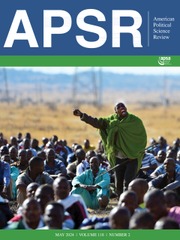Crossref Citations
This article has been cited by the following publications. This list is generated based on data provided by
Crossref.
Saunders, Elizabeth N.
2012.
The Electoral (Dis)Connection in U.S. Foreign Policy.
SSRN Electronic Journal,
Potter, Philip B.K.
2012.
Which Ties Bind? Globalization, Mobility, and International Conflict.
SSRN Electronic Journal,
Sieberg, Katri
Clark, David
Holt, Charles
Nordstrom, Timothy
and
Reed, William
2013.
An Experimental Analysis of Asymmetric Power in Conflict Bargaining.
Games,
Vol. 4,
Issue. 3,
p.
375.
Markowitz, Jonathan N.
and
Fariss, Christopher J.
2013.
Geopolitical Competition and the Rise of Naval Power.
SSRN Electronic Journal,
Chilton, Adam S.
2014.
The Laws of War and Public Opinion: An Experimental Study.
SSRN Electronic Journal,
Hasenclever, Andreas
2014.
Handbuch Internationale Beziehungen.
p.
1.
Horowitz, Michael C.
2014.
Who's Afraid of 'Killer Robots'? Public Opinion and Autonomous Weapons Systems.
SSRN Electronic Journal,
Kreps, Sarah E.
and
Wallace, Geoffrey P.R.
2015.
International Law, Military Effectiveness, and Public Support for Drone Strikes.
SSRN Electronic Journal,
Hyde, Susan D.
2015.
Experiments in International Relations: Lab, Survey, and Field.
Annual Review of Political Science,
Vol. 18,
Issue. 1,
p.
403.
McDonald, Patrick J.
2015.
Great Powers, Hierarchy, and Endogenous Regimes: Rethinking the Domestic Causes of Peace.
International Organization,
Vol. 69,
Issue. 3,
p.
557.
Cuhadar, Esra
and
Druckman, Daniel
2015.
Handbook of International Negotiation.
p.
3.
Horowitz, Michael C.
2015.
Public Opinion and the Politics of the Killer Robots Debate.
SSRN Electronic Journal,
Holmes, Marcus
and
Traven, David
2015.
Acting Rationally Without Really Thinking: The Logic of Rational Intuitionism for International Relations Theory.
International Studies Review,
p.
n/a.
Reiter, Dan
2015.
Should We Leave Behind the Subfield of International Relations?.
Annual Review of Political Science,
Vol. 18,
Issue. 1,
p.
481.
BAKER, ANDY
2015.
Race, Paternalism, and Foreign Aid: Evidence from U.S. Public Opinion.
American Political Science Review,
Vol. 109,
Issue. 1,
p.
93.
Kaarbo, Juliet
2015.
A Foreign Policy Analysis Perspective on the Domestic Politics Turn in IR Theory.
International Studies Review,
Vol. 17,
Issue. 2,
p.
189.
STEIN, RACHEL M.
2015.
War and Revenge: Explaining Conflict Initiation by Democracies.
American Political Science Review,
Vol. 109,
Issue. 3,
p.
556.
Bell, Mark S
and
Quek, Kai
2015.
Realism, Idealism, and American Public Opinion on Nuclear Disarmament.
SSRN Electronic Journal,
Winters, Matthew S.
and
Weitz-Shapiro, Rebecca
2015.
Political Corruption and Partisan Engagement: Evidence from Brazil.
Journal of Politics in Latin America,
Vol. 7,
Issue. 1,
p.
45.
Levy, Jack S.
McKoy, Michael K.
Poast, Paul
and
Wallace, Geoffrey P.R.
2015.
Backing Out or Backing In? Commitment and Consistency in Audience Costs Theory.
American Journal of Political Science,
Vol. 59,
Issue. 4,
p.
988.



Comments
No Comments have been published for this article.